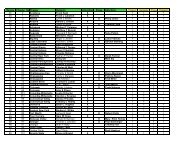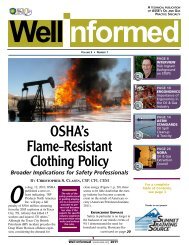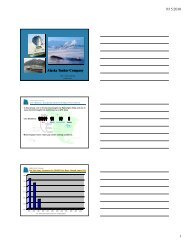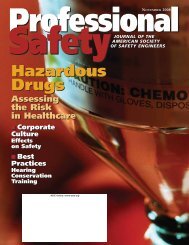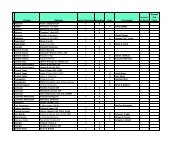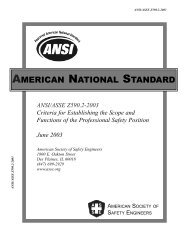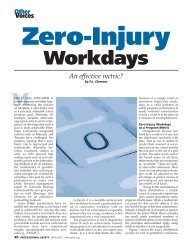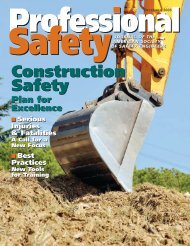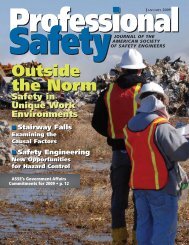Safety & Health Effects of Shift Work - ASSE Members
Safety & Health Effects of Shift Work - ASSE Members
Safety & Health Effects of Shift Work - ASSE Members
You also want an ePaper? Increase the reach of your titles
YUMPU automatically turns print PDFs into web optimized ePapers that Google loves.
ELECTRICAL SAFETY<br />
BY MICHAEL KOVACIC<br />
NFPA 70E: Fact, Fiction or Fad<br />
Knowledge, and<br />
the desire and<br />
ability to implement<br />
that knowledge,<br />
saves lives<br />
and prevents injury.<br />
Afew months ago, I was giving several short sessions<br />
on NFPA 70E at a national safety conference.<br />
One <strong>of</strong> the attendees, whom I have known<br />
for years, saw me outside the conference room<br />
in between sessions and said, “Are you still talking about<br />
70E” I quickly responded, “Of course! Employees are<br />
still being injured and killed by electricity, aren’t they”<br />
But I thought about that comment for weeks . . . what<br />
did he mean, still talking about it And then, a comment<br />
from a customer a few weeks ago put it into the perspective<br />
I was missing: “I wish we would get over this 70E<br />
fad already!”<br />
I realized that “NFPA 70E” and “arc flash” have<br />
become such buzz words that many employers and<br />
employees who do not understand the<br />
core <strong>of</strong> what NFPA 70E is trying to<br />
accomplish see it as simply the latest<br />
safety fad. And some people even<br />
promote “fiction” in an effort to sell<br />
more product or services. So, what<br />
are the basic facts about NFPA 70E<br />
Fact: NFPA 70E is not a new<br />
standard; the first NFPA 70E committee<br />
was established in 1976 and<br />
the first edition <strong>of</strong> NFPA 70E was<br />
published in 1979. The primary focus <strong>of</strong> what NFPA<br />
70E is, electrical safety-related work practices, made an<br />
entrance with the 1981 edition 30 years ago.<br />
If you do not currently own NFPA 70E, it is time to<br />
get a copy. If you have never looked at NFPA 70E, the<br />
National Fire Protection Association has the text available<br />
to view (you cannot copy or print from the viewer)<br />
on its website.<br />
Fact: Arc flash and arc blast are not new electrical<br />
hazards made up by sales people to sell PPE. The book,<br />
Electrical Injuries—Their Causation, Prevention and<br />
Treatment, by Charles A. Lauffer, M.D., was first published<br />
in 1912. The first chapter discusses the cause, prevention<br />
<strong>of</strong> and treatment <strong>of</strong> arc flash injuries. So, arc<br />
flash hazards have been discussed for at least 100 years.<br />
Numerous statistical and research organizations have<br />
produced various studies about workplace injuries over<br />
the last few years, but they all conclude the same general<br />
information. Between five and 10 arc flash incidents<br />
occur in electrical installations in the U.S. every day, representing<br />
a significant number <strong>of</strong> injuries and fatalities<br />
each year. <strong>Work</strong>place electrical injuries represent a significant<br />
cost to employers each year, and lockout/tagout<br />
and electrical regulations continue to make OSHA’s top<br />
ten most cited regulations each year.<br />
Fact: OSHA has not adopted NFPA 70E. Sections<br />
1910.331-.335 <strong>of</strong> Subpart S <strong>of</strong> the OSHA regulations<br />
essentially mirror NFPA 70E. In many ways, Subpart S is<br />
the “protect your workers” regulation,<br />
and NFPA 70E is the how-to<br />
guide. OSHA does, and will continue<br />
to, reference and enforce<br />
NFPA 70E in its compliance and<br />
consultation activities, so if you<br />
have been waiting for OSHA to<br />
adopt NFPA 70E before you start<br />
implementation at your facility,<br />
you can stop waiting and start<br />
implementing.<br />
UNDERSTANDING & IMPLEMENTING<br />
NFPA 70E FOR A SAFER WORKPLACE<br />
Chapter 1 <strong>of</strong> NFPA 70E, titled “<strong>Safety</strong>-Related <strong>Work</strong><br />
Practices,” addresses the electrical safety-related work<br />
practices and procedures necessary to safeguard employees<br />
from hazards arising from the use <strong>of</strong> electricity in the<br />
workplace. The chapter provides a progressive guide to<br />
implementing safe work practices in your workplace.<br />
KNOWLEDGE IS KEY<br />
Knowledge, and the desire and ability to implement<br />
that knowledge, saves lives and prevents injury. OSHA<br />
documentation shows that it is <strong>of</strong>ten unsafe work practices<br />
that lead to electrical injury and death, while additional<br />
investigation data indicate that employees who<br />
used unsafe work practices <strong>of</strong>ten did not have knowledge<br />
<strong>of</strong> safety-related work practices.<br />
Chapter 1 <strong>of</strong> NFPA 70E addresses employee training<br />
requirements quickly. Section 110.6, titled “Training<br />
Requirements,” outlines the need for training “employees<br />
who face a risk <strong>of</strong> electrical hazard not reduced to a safe<br />
level by the applicable installation requirements [National<br />
Electrical Code and OSHA 1910.301-.308].” As almost<br />
every workplace uses electricity, this one simple statement<br />
tells employers that all employees need a level <strong>of</strong> training<br />
adequate to understand the “specific hazards associated<br />
with electrical injury,” the relationship between electrical<br />
hazards and possible injury,” and the “safety-related work<br />
practices and procedural requirements necessary to provide<br />
protection from those electrical hazards.”<br />
The section also addresses the specific training necessary<br />
for “qualified” persons and provides a basis for<br />
establishing who actually is qualified. One <strong>of</strong> the most<br />
important changes to the 2009 edition was the addition<br />
<strong>of</strong> Section 110.6(D)(1)(e), which requires that persons<br />
considered “qualified” be able to demonstrate the appropriate<br />
use <strong>of</strong> a voltage detector. The added requirement<br />
helps clarify that additional and specific skills and<br />
knowledge are necessary for an employee to be considered<br />
“qualified.”<br />
This section <strong>of</strong> NFPA 70E closely corresponds with<br />
20<br />
Safely Made www.asse.org 2011




